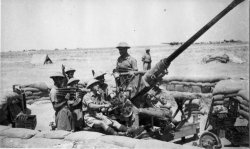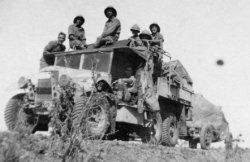Patrons:
Air Marshal Sir Ian Macfadyen
The Lieutenant Governor, His Excellency Lieutenant General Sir John Lorimer KCB DSO MBE
The History of the 15th (I.O.M.) L.A.A. Regiment R.A. (T.A.)
On 24th August, 1939, the Regiment was mobilised and sailed to Liverpool to take up the anti aircraft defence of the Mersey from Gladstone dock to Princes landing stage. Four days later, 129 Battery was raised on the Isle of Man to complete the Regiment’s establishment of three Batteries. Shortly after the outbreak of war on 3rd September, 1939, a Company of A.T.S. was also raised on the Island and was affiliated to the Regiment for service in Great Britain, joining them for duty at the end of that month.
In October, 1939 the Regiment was dispersed for operational duties in the Midlands and south-west of England. The Batteries and their Troops first served in the Cotswolds area protecting airfields, and later in places as wide apart as Portsmouth, Southampton, the Isle of Wright, Dorset and Plymouth during the Battle of Britain.
On 19th November, 1940, the Regiment embarked for the Middle East, disembarking in Egypt. There, to meet the great demand for light anti aircraft artillery, the Batteries parted company. 41 Battery sailed for the East African theatre of war and fought with the famous 4th and 5th Indian Divisions in the Sudan, Eritrea and Abyssinia and witnessed the surrender of the Italian forces. 129 Battery sailed for Crete, where in May 1941, all except one officer and thirty others were taken prisoner. 129 was the last defensive Battery in action in Crete before it was overrun by the German forces. In the meantime, Regiment H.Q. and 42 Battery remained in Egypt and were responsible for the anti aircraft defence of the Suez Canal from Port Said to Suez, in which task they were joined by 41 Battery on its return from East Africa.
Early in 1942, 1st Battery, the Senior Regular A.A. Battery of the British Army, with experience in France prior to Dunkirk and the first desert push under General Wavell, joined the Regiment to replace the 129 Battery. The Regiment then moved into the Libyan desert and did forward work with desert columns. Then back to Alamein in the setback of June 1942. In July, 1942, the Regiment joined the famous 7th Armoured Division (the Desert Rats) and remained with the Division until the end of the War.From 23rd of October, 1942 (Alamein Day), the Regiment moved forward (not without fighting, and not without casualties) from Alamein through Libya, Cyrenaica, Tripolitania and finally Tunisia to witness the final surrender of all the enemy forces in North Africa. Then across to Italy, landing at Salerno, then on to Naples, the crossing of the Volturno and on to the Garigliano river.
In January, 1944, the Regiment returned to England and for five months refitted and trained for the Normandy Invasion on 6th June, 1944. Landing on the beach by Ouvranches, the Regiment were involved in many famous battles on the journey through France, Belgium, Holland and finally to Hamburg and the final surrender of the German armies, and the end of the War in Europe.
During all their campaigns, men of the Regiment had shot down planes, and shot up tanks and infantry, acting not only as anti aircraft gunners, but also in the role of anti-tank gunners and light artillery as well.
With over 300 planes actually shot down, and with its lengthy record of active service overseas against the enemy, the Regiment is unrivalled by any other light anti aircraft Regiment in the British Army, and can claim to have lived up to the gunners' two proud challenges "Ubique" and "Quo fas et gloria ducunt".


